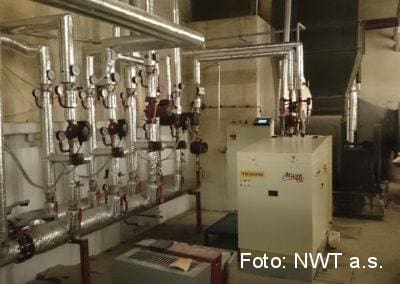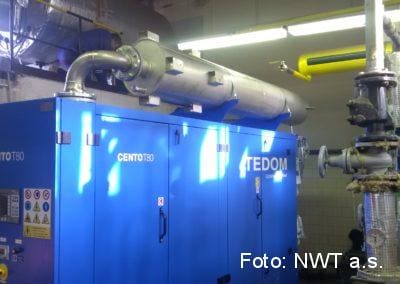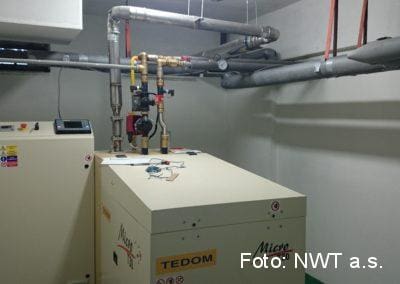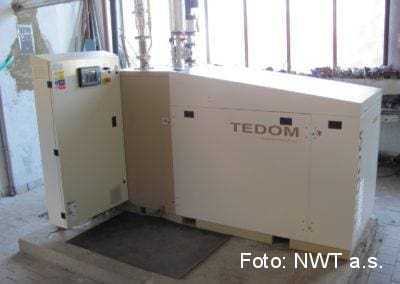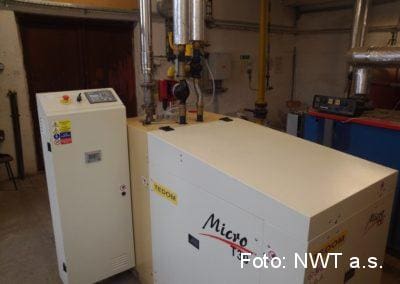Kogenerační jednotky
Cogeneration unit is a device for combined production of electricity and heat.
In the process of cogeneration, the waste heat which is produced during electricity production is meaningfully used.
PRINCIPLE OF COGENERATION UNIT
Cogeneration units does not serve as a complete replacement of existing heat source. It is more like an extension or improvement of the existing system using a technology with short pay-back times. The return dependent on current price of heat and electricity is between 4 and 8 years. Furthermore, when the heat is supplied from a central source for a price higher than 500 CZK/GJ, the pay-back time is even shorter (2-3) years.
During the installation of the cogeneration we are happy to take care of the complete renovation and modernization of the boiler room. We replace the old boilers with new ones with lower performance which not only save your money but will also cooperate much better with the cogeneration technology.
When it comes to projects with high return on investment, there is a possibility of discussion about partial or full finance of the investment without dealing with any financial institution.
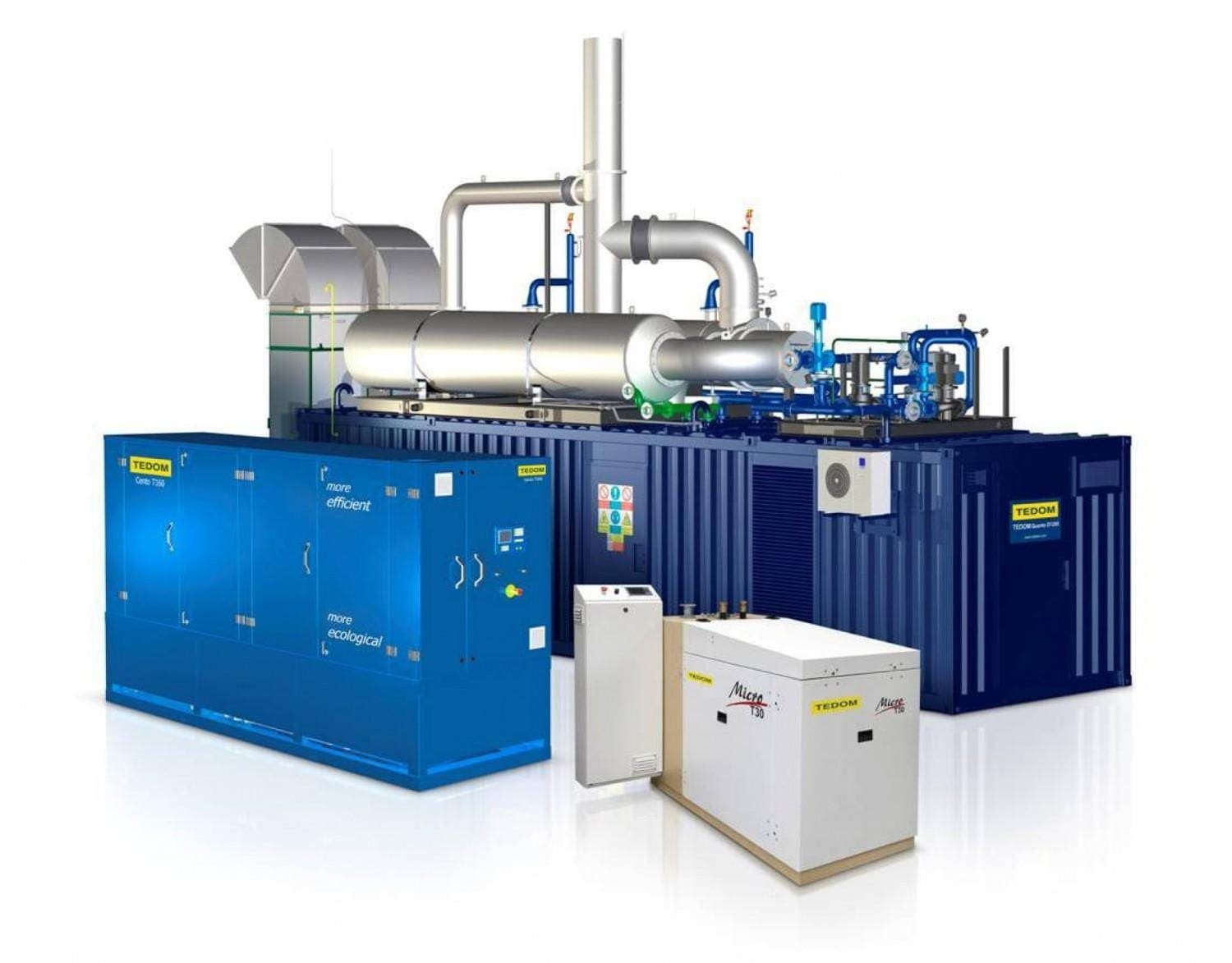
THE USE OF COGENERATION UNIT
Why?
During cogeneration, combined production of electricity and heat, there is a high utility of energy in the fuel, which can be up to 95 %. The whole process meaningfully uses heat created during production and thanks to that it saves fuel and finances needed for its purchase.
Where?
Cogeneration is suitable everywhere where there are requirements for offtake of heat or cold. Necessary prerequisite for applying a cogeneration is a utilization of entire heat produced. That can also be reached by combining cogeneration with suitable accumulation tank. In this case is the cogeneration unit works only in time of higher drawing of subsidy on electricity from the cogeneration. The produced heat is accumulated and subsequently used also in the time when the cogeneration is not operating.
The electricity from the cogeneration unit is used for own consumption of the building, where the unit is placed, or it can be supplied to the grid. The heat from cogeneration unit is used for heating buildings, preparation of domestic hot water, or technological heat. Cogeneration units can be also used as an emergency source of electric energy in places of its constant need.
How?
It is a combination of combustion engine, electric generator, heat exchanger system, and a system which allows the controlling of the unit both locally and remotely using PC, Internet or cell phone.
Small cogeneration units on the basis of gas engines fall into decentralized sources of energy. That means that the production of electricity and heat is happening near its place if utility. Thanks to that the losses caused by transport and distribution of electricity are zero. Very small units are now available with power starting at units of kilowatts.
The dominant fuel for running cogeneration is natural gas. Although, in past few years there is an increase of the number of devices using biogas, landfill gas, sludge gas or other alternative fuels – e.g. mine gas. Around the world we can find more peculiar variants: fish oil, coconut oil, fumes from glues in plastic or wood processing industry.
Further information
Find out more about possibilities of use of cogeneration units and its short payback periods.
Advantages of combined production of heat & electricity
Fuel saving –Use of combined production of heat and electricity leads to approximately 40% saving of fuel. Talking money, it means that for the same amount of energy the investor pays only 60 % financial means.
Saving of costs on purchasing energy –From the same amount of fuel the investor gets about twice more energy. Costs are lowered also by that, that for every kWh of electric energy produced the investor gets payed monthly or quarterly.
Minimalization of energy distribution – heat and electric energy is produced on the place of its own consumption which leads to zero distribution costs and losses caused by long distance distribution. Heat produced in cogeneration unit is used for heating buildings, preparation of domestic hot water or preparation of technological heat.
Ecological production process –because the combined production of heat and electric energy saves about 40 % of fuel, the burden on environment with cogeneration is much lower than with other energy sources.
Energy in the case of emergency –cogeneration units serve also as a back-up source in areas where it is necessary to ensure non-stop supply of electricity and heat.
Production of cold –using absorption exchanger the produced heat can be also used for production of cold for technological purposes or air conditioning. In this case, it is called trigeneration – combined production of electricity, heat, and cold.
Fields of use
- Central sources of heat (heating plants, central boiler rooms of compounds or housing estate)
- Wastewater treatment plant
- Industry with constant consumption of heat or cold (glassworks, ironworks, drying rooms, etc.)
- Food industry (meat or milk processing, etc.)
- Wellness centres, swimming pools, geothermal spa
- Schools, administrative buildings, hospitals, etc.
Good return on investment
It is of course dependent on the type of technologies which are installed and how is the heat and electric energy used. For each system we prepare an energy audit and a tailored price offer which will include ideal and unique solution for particular case and investment.
According to our experience the payback period is between 4-6 years. Realizations with payback period shorter than 3 years of operation are no exception.
The utility of waste heat from heat source using heat pump
NWT a.s. has a long-term cooperation with firm HELORO Ltd. which is the owner if an innovative system for processing waste heat, patently secured by industrial utility design, registered at the Industrial Property Office of the Slovak Republic under the number SK 6120 Y1.
Input medium to drive the system
- Natural gas
- LPG
- Biogas (min. content methane content 50%)
Technologies necessary for system operation
- Cogeneration or trigeneration unit
- Heat pump
- Heat exchanger
- Adjustment of existing system and interconnection of technologies
Advantages and increase of efficiency
- Decreasing the consumption of input medium = saving of costs
- Profits from production and consumption of own electric energy
- Overall decrease of required maximum power of the system
- Permanent use of condensed heat from flue gas from boilers
- Nox separation from flue gas = decrease of generated volume of emission allowances
- Increased efficiency of installed boilers and cogeneration units more than 115 %
FAQ
Summary of frequently asked questions about the operation and functions of cogeneration units
What is cogeneration
The term cogeneration stands for a combined production of electric energy and heat. Compared to classic sources, in which heat arising during production of electric energy is released to the environment without utility, cogeneration is using the heat for heating of the building or heating of domestic water and thereby it saves fuel and finances needed for other purchase of energy.
What is the advantage of cogeneration and how efficient it is?
Electric energy in every power plant is produced by spinning electric generator using turbines. Heat needed for producing vapour which keeps the turbines running is usually acquired from combustion of coal or fission of the uranium nucleus. Huge part of heat is not utilized. Efficiency of the production in thermal power plants is around 30 %. Most modern vapour-gas power plants reach about 50 % efficiency. Even though further losses up to 10 % arise during transformation of voltage and long distribution of electric energy.
In cogeneration unit electric energy is produced using same process as in other power plant devices – spinning electric generator using piston internal combustion engine. Engines in cogeneration unit are normally constructed for use of natural gas, although they can combust other liquid and gaseous fuels.
Heat which is released in the combustion engine is effectively used by cooling of the engine, oil and flue gas and thanks to that is the efficiency of cogeneration between 80 – 90 %.
How does the process of approving the operation of cogeneration unit works?
Similarly like in the case of photovoltaics, indeed it is also a source (production) of electric energy, which works parallelly with the grid. For the service itself you need a licence from Energy Regulatory Office (the Slovak Regulatory Office for Network Industries). For construction of the cogeneration unit you need a building permit. If the electricity is supposed to be supplied to the distribution network, an approval to remove electric power from the locally competent distribution system operator is needed.
Cogeneration units with heat power of 200 kW – 5 MW are further considered for medium pollution sources and it is therefore necessary to have a building permission and a permission for operation from the Department of Environment of the locally competent regional authority. Cogeneration units with higher performance placed in buildings it is also necessary to count with that that hygiene stations may require a noise measurement (noise studies).
SELECTED TESTIMONIALS
Below you can find realizations and solutions of cogeneration units
Are you interested or do you have any questions?
Call us
nonstop customer service:
+420 800 570 570
Our office
tř. Tomáše Bati 269
760 01 Zlín
+420 800 570 570
obchod.energo@nwt.cz

